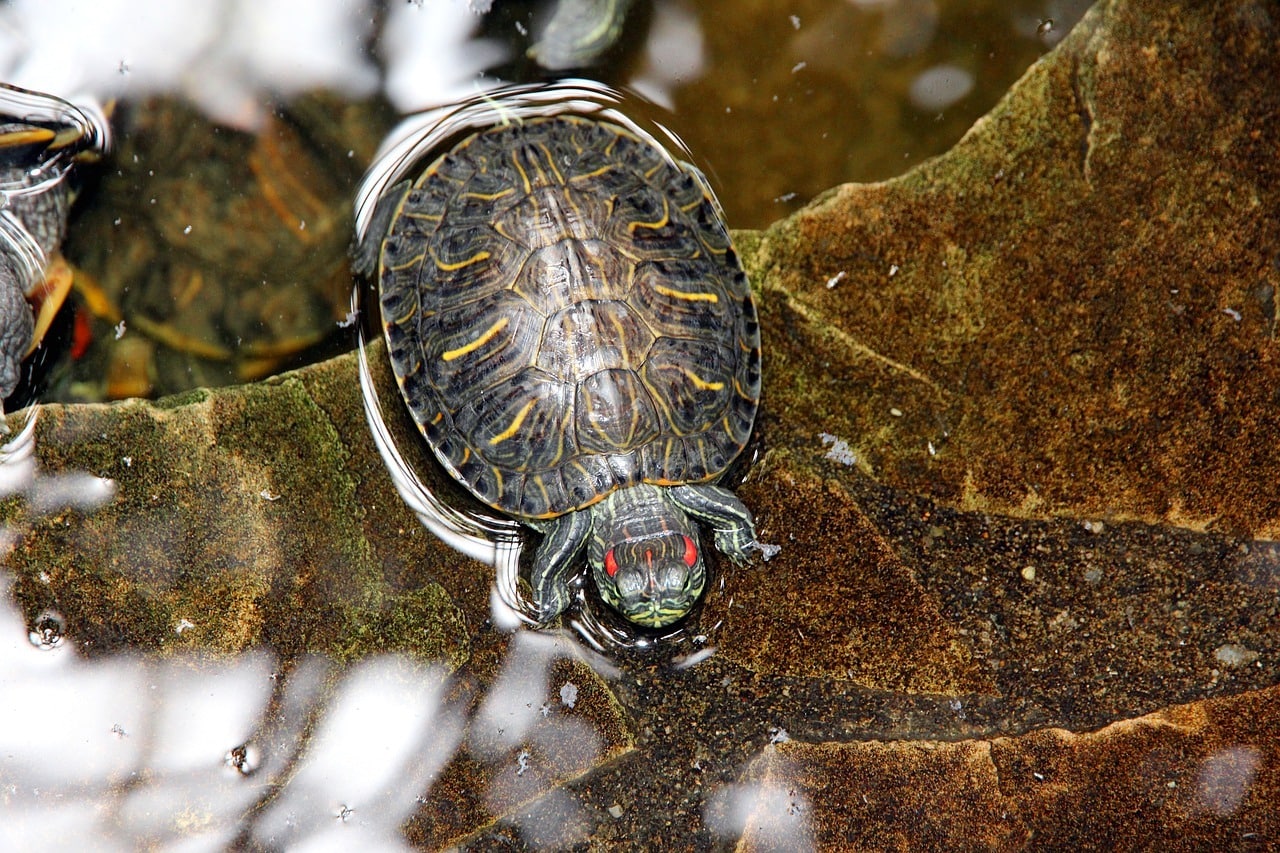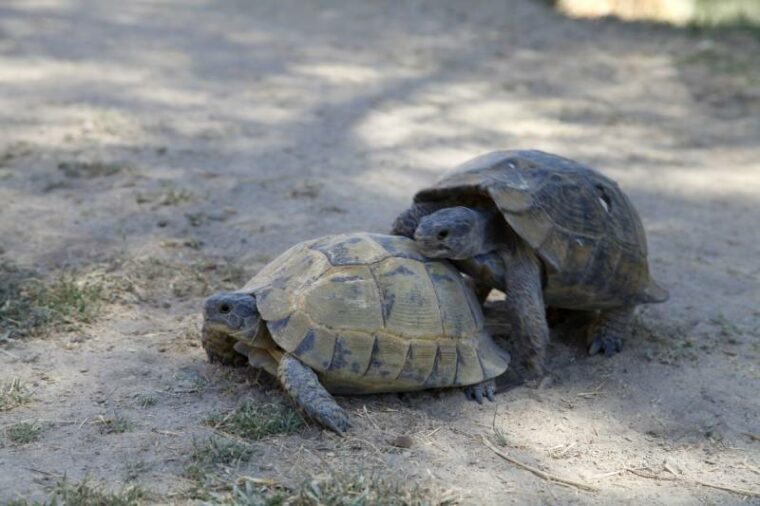
Click to Skip Ahead
With their slow movements and cumbersome shells, it’s easy to wonder how tortoises can accomplish much of anything, including breeding. Tortoises follow a unique process from courtship to egg-laying, often relying on ideal conditions at every stage to allow for successful hatching after several months. If you’ve ever wondered how tortoises mate, we’ll reveal all with this look at their intriguing and unexpected breeding habits.
When Do Tortoises Mate?
Tortoises usually start the courtship and mating process in the spring and summer. Geography, hibernation habits, and unique preferences of the species will determine a tortoise’s timing. For instance, the Hermann’s tortoise will breed when it wakes in February or March, while the Sulcata tortoises of the Sahara typically wait until September to mate.

How Old Are Tortoises When They Mate?
Tortoises become sexually mature when the carapace reaches a particular size, which varies according to the species. Smaller tortoises tend to mate earlier than larger tortoises, with some taking as few as 4 years to begin and others taking 25 years or more.
Captivity will also affect the speed at which tortoises mature. With plenty of food and an ideal habitat, captive tortoises may reach their mating size in half the time it takes a wild tortoise.
Tortoise Courtship
As the mating season begins, males seek out females by picking up their scent and checking for visual markers until they find a mate. Tortoises typically become highly aggressive during this period.
If two males have the same target, they will try to display dominance. They’ll often try biting their competitor or use their head and neck to flip them over. As tortoises are polygamous, some males breed with several females in a single season, while less assertive individuals generally mate more infrequently.
When they find a potential mate, males bob their heads, ram into and circle the female, and nip at her front legs and shell. Some species are more aggressive than others, but wooing and attracting mates isn’t standard practice for any tortoise.
Females don’t engage in mating displays but are picky about their mates. It often takes several courtship attempts for them to be willing. When the female submits, she retracts into her shell. The male identifies this as his cue to begin copulation.
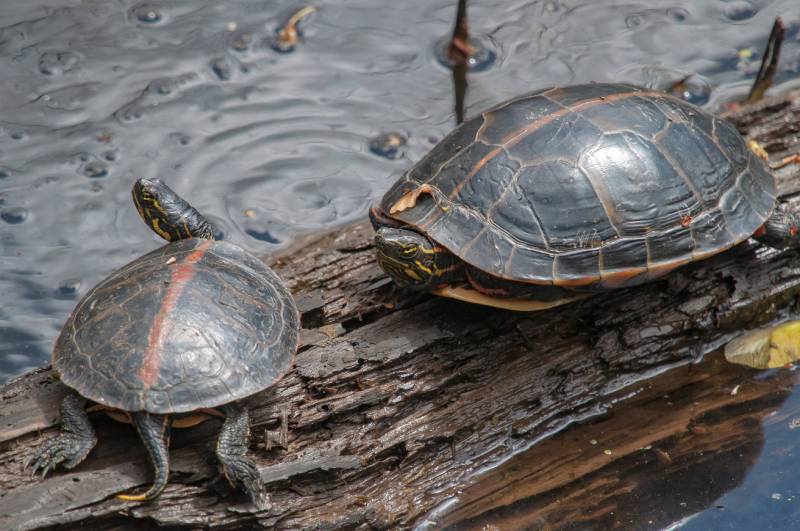
How Tortoises Mate
The male will mount the female, circling to her rear and rising on his hind legs while positioning his front feet on her shell. Unlike the female, which has a flatter plastron, the male has a concave underside to better rest against the female’s domed shell. He’ll adjust his tail to align the ventral opening of the cloaca with the female’s and prepare for insertion. The cloaca stores the reproductive organs, with the male’s penis emerging from his to insert into the female.
Males stamp their feet and are vocal during the brief mating sessions, which can occur several times before they dismount. They use their grunts, hisses, and high-pitched squeaks to keep the female engaged, though she’ll sometimes try to escape regardless.
In ideal conditions, egg-laying usually begins a few weeks after mating, though predicting when (or even if) the female will lay them isn’t easy. Females will wait for the optimal moment, with some able to hold onto the male’s sperm for several years and still produce viable offspring.
How to Tell If a Tortoise Is Carrying Eggs
Although some females can hold over 30 fertilized eggs, they split them among several clutches throughout the year. One tortoise may produce 2–12 eggs at a time but have 1–4 clutches in a season. Larger species tend to have smaller, rounded eggs in greater abundance than small-bodied tortoises, which produce bigger, elongated eggs.
Knowing when a female tortoise is carrying eggs, or “gravid,” is an essential aspect of ownership, as tortoises need extra supplements and the right environment to improve the chances of healthy offspring. Given their capacity to hold off on the process for so long, you’ll have to look for signs rather than try to time it out. Here are a few indicators that a tortoise is gravid.
Appetite Changes
After a recent mating period, a female tortoise carrying eggs will change her eating habits. She has to make room for the growing eggs. After a brief period of eating more than usual, the pregnant tortoise will focus less on food and more on setting up a nesting area. Appetite changes like this vary between species, and you may see no difference even as your tortoise prepares to give birth.
Restlessness
Unusual habits and everyday temperament can indicate many changes in your tortoise, including a growing collection of eggs in her body. Increased signs of discomfort, irritability, and restlessness are typical as the tortoise tries to adapt. As with shifts in appetite, restlessness may also indicate stress from the environment or an illness requiring further investigation.
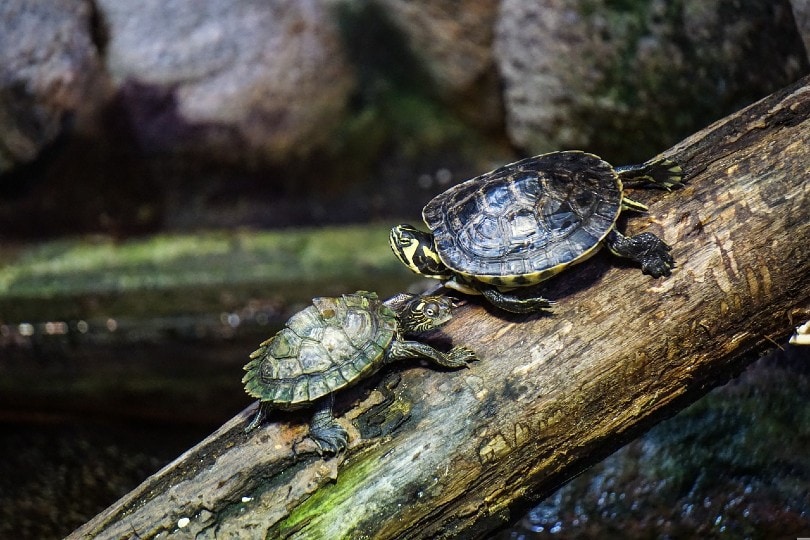
Digging
Digging tortoises are usually doing so to set up a nest site. Kicking and shoveling with their legs, females dig out a shallow hole to leave their clutch. They use the hind legs to finish up and shape the cavity to store the eggs.
Feel & Look for Eggs
If you see the signs of a gravid tortoise, you can take your tortoise to your exotics vet for confirmation. They may use a palpate technique as discussed below or confirm the presence of eggs with an x-ray. The palpate technique involves lifting and holding the tortoise carefully and feeling for the soft area under the plastron behind the hind leg. With gentle pressure, you’ll notice either soft tissue yielding to your touch or firm round objects indicating an abdomen full of eggs. Bear in mind that the eggs can get damaged if you apply too much pressure, so this technique is best undertaken by someone with experience.
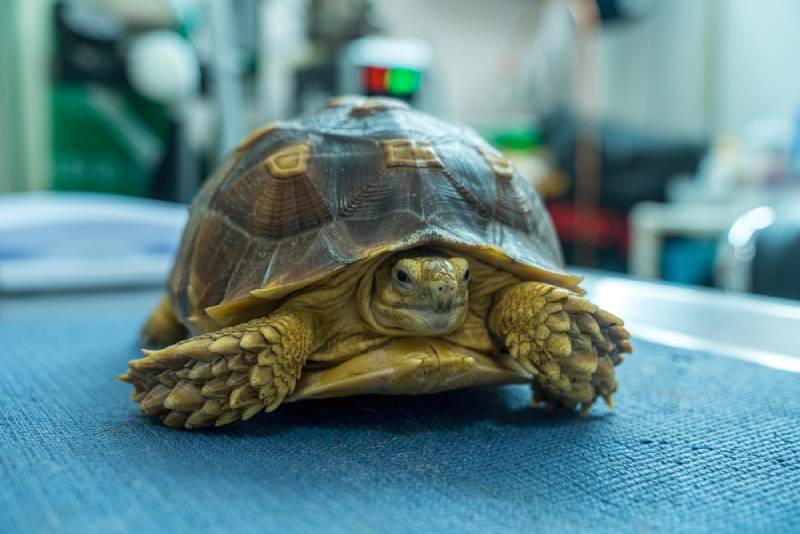
Tortoise Nesting Habits
To build their nest, females seek accessible, relatively soft dirt or sand. Heat and humidity must be in the ideal range before they pick a digging spot. Tortoises prefer a sunny, well-drained area that keeps warmth and moisture levels up without leaving the eggs swimming in water. When they find it, females dig a hole a few inches deep over several hours and release a clutch into it.
After refilling the hole with dirt to cover the eggs, females will tamp it down with their plastron for good measure. They then leave the eggs to incubate and hatch. Incubation time depends on the temperature and species, 8-11 weeks is average for most species. Newborns will have to fend for themselves once they enter the world.
How Can You Get Tortoises to Mate?
Tortoises aren’t always gung-ho about mating, and trying to force the issue will usually leave you disappointed. Setting up a comfortable environment that promotes positive interactions between males and females is one of the most crucial aspects of ensuring success.
Tortoises need plenty of space to let the female retreat when necessary to avoid stress. In many cases, that means separating the male and female, only bringing them together to mate. With the proper setup, you can’t do much more than sit back and wait for your tortoises to hit it off.
Females need a soft, moist nesting area to ensure their comfort when laying their eggs. Suitable nesting sites are crucial to prevent the tortoise from retaining her eggs for too long. If the eggs are retained for too long she is in danger of ‘egg binding’ or egg peritonitis which is a serious condition and can prove fatal.
Final Thoughts
Not all tortoise species share the same breeding schedule despite similar courtship and mating behaviors. Getting them to pair isn’t always easy, often coming down to creating the perfect mood and guiding the interactions to make the female interested. It takes patience and a learning period to grasp the nuances of your species, but with this understanding of how tortoises mate, you’re one step closer to keeping an ideal environment for successful breeding.
Related Reads:
Featured Image Credit: SABANCANPHOTOGRAPHY, Shutterstock






